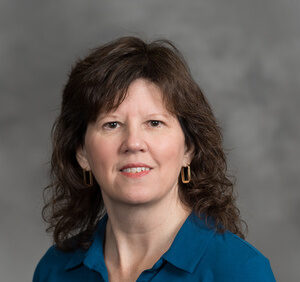Dr. Aebersold’s professional and academic career is focused on advancing the science of learning applied in simulation to align clinician and student practice behaviors with research evidence to improve learner and health outcomes. She focuses her scholarship in both high fidelity and virtual reality simulation and is a national leader and expert in simulation. Her scholarship has culminated in developing the Simulation Model to Improve Learner and Health Outcomes (SMILHO).
Current Research Grants and Programs:
- Closing the loop: new data tools for measuring change in the quality for nursing education and the value of new approaches to instruction (PI) University of Michigan School of Nursing.
- Interactive anatomy-augmented virtual simulation training (PI with Voepel-Lewis) Archie MD Award Number 045889
Profile: Building a Better Nurse
By Dan Meisler
Communications Manager, ARC
Michelle Aebersold has spent her career trying to “build a better nurse,” through training development, virtual clinical environments, and patient simulations.
As Director of Simulation and Educational Innovation at the U-M School of Nursing, Aebersold is focused on creating realistic learning environments for nursing students.
But it wasn’t until relatively recently that she realized she had an under-utilized but powerful tool at her disposal — data.
For years, Aebersold has been collecting data on how student performance is affected by participation in various simulations, but it wasn’t until speaking to faculty from the Michigan Institute for Data Science (MIDAS) that she realized the potential insights all of her historical datasets might have hidden inside.
“We’re trying to pull them all together to create a common thread, so that as we collect data on our students, we can follow them to say how they progressed. How many simulations and what type of simulations did they get and how did that impact their learning?” Aebersold said. “We hit students with a lot of simulations while they’re in school, but we don’t necessarily know which ones are better for certain things.”
Now, as MIDAS core faculty member, Aebersold will be able to easily collaborate with other MIDAS researchers to refine and analyze her data.
Eventually, she said, she’d like to be able to track nursing students as they enter their first jobs to see how their training translates to real-world performance. And a further goal for Aebersold is to help the practice of nursing education become similar to the training world-class athletes receive, in which, for example, subjects review videos of their performance to identify what works and what doesn’t.
“We’re going to introduce some things, like what can we do with virtual simulations, or what can we do with eye-tracking,” she said. “We really want to try to dive deeper, by being able to put all this information together using a lot of these data science methods.”
Aebersold has been at U-M since the mid-1980s, serving in a variety of clinical and administrative roles. She earned a Ph.D in Nursing from the University in 2008, and served as Director of the Clinical Learning Center in the School of Nursing for eight years thereafter. Since 2016, she’s been Director of Simulation and Educational Innovation.
One of Aebersold’s recent projects, “Closing the Loop: New Data Tools for measuring Changes in the Quality of Nursing Education,” applies modern data-science tools to help understand the correlation between traditional tests and student skills and competence when they enter the workforce, and whether simulations coupled with debriefing sessions translate into improvements in skills and in test outcomes.
Another potential project will focus on comparing the eye movements of novice nurses to expert nurses. Aebersold said initial findings have shown that nurses with more experience tend to focus their eyes on one thing for longer periods of time than those with less.
She said she’s enlisting help on that work from professors in the School of Information at U-M.
“By really understanding the difference between how experts do things and novices do things, you can help develop simulations that help novices get better,” Aebersold said.
She credits her father with starting her on the path to becoming a nurse; he was a police officer, and would sometimes take her to the local emergency room.
“I loved the fast pace,” she recalled, and the chance to have a real, positive impact on people’s lives.
After earning a nursing degree from Madonna University, she became a critical care nurse. She then gravitated toward supervision and administration, gaining a masters in business administration, also from Madonna University. She earned her Ph.D. from U-M while working as a nurse manager at the U-M health System.
She said all the technology, data, and innovative modes of study she’s brought together are all in service of one goal.
“For me, it all comes down to how can we make the patient care environment safer for our patients,” she said.
